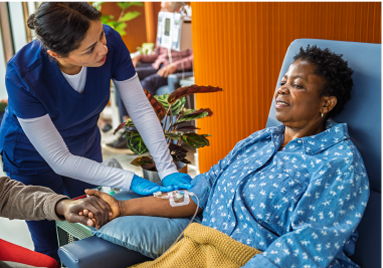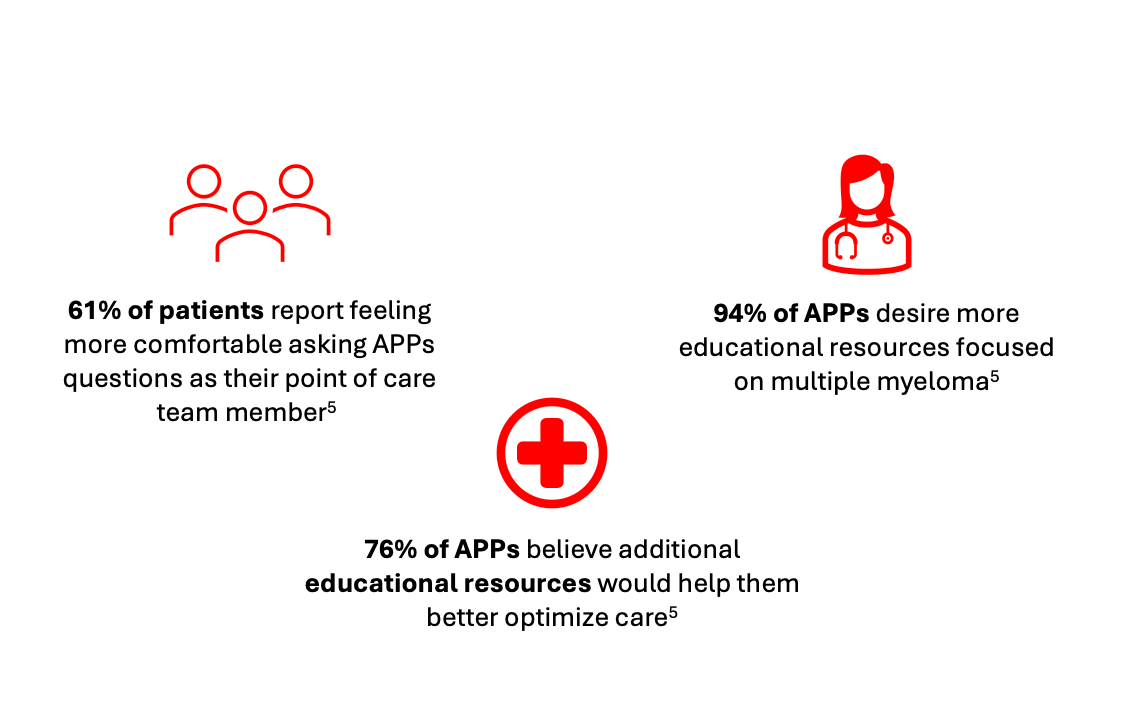APPs Bridging Science and Care: Understanding and Advocating for Bispecifics in Later Line Multiple Myeloma

When a new treatment enters the landscape—especially ones as promising and complex as bispecific antibodies—it's natural to feel both excitement and hesitation about what it means for your patients.
For advanced practice providers (APPs) and care teams supporting people with relapsed/refractory multiple myeloma, a highly variable and incurable blood cancer, bispecifics represent a powerful option, offering hope after multiple lines of therapy.
“Many bispecifics-related conversations I’ve had with patients began when they were navigating relapse,” said Kevin Brigle, PhD, ANP. “By proactively discussing treatment options—including emerging therapies such as bispecifics—we help ensure patients are informed and empowered to make decisions that feel right for them. Today’s patients have access to an unprecedented range of options, and many may feel more confident knowing these choices exist.” Brigle, who provides education and support to patients exploring advanced multiple myeloma treatments, has worked closely with patients navigating bispecific therapy options.
Bispecifics are helping to transform the treatment landscape for multiple myeloma. Their molecular design, which allows them to target both an antigen/receptor and an immune system cell, enables a person’s own body to help identify and destroy myeloma cells. By binding one arm to cells expressing a target antigen (such as BCMA on myeloma cells) and the other to CD3 on a patient's T-cells, bispecifics act as a molecular bridge, activating T-cells, to directly attack multiple myeloma cells.1
“Bispecifics leverage a person’s own immune system, which has a natural defense against cancer cells. This treatment gives the immune system a further jump,” said Denice Gibson, DNP, RN, CRNI, BMTCN, AOCNS, who works directly with patients ready for bispecific therapy within a community oncology practice.
Recent clinical trials of bispecific antibodies have demonstrated encouraging clinical activity and response rates in heavily pretreated multiple myeloma populations.2 While safety profiles continue to evolve, these emerging treatment options show potential to address unmet needs in later lines of therapy.
However, bispecifics also introduce operational challenges, particularly around step-up dosing, monitoring for side effects like cytokine release syndrome (CRS) and neurotoxicity, and navigating logistical hurdles, especially in community settings.
APPs are central to ensuring bispecific therapies not only reach patients but are delivered effectively and safely through careful management of step-up dosing and monitoring.
APPs as Educators, Coordinators, and Advocates
From identifying early symptoms of CRS or immune effector cell-associated neurotoxicity syndrome (ICANS) to guiding patients through insurance and scheduling logistics, APPs are often the steady hand guiding patients through their most vulnerable moments.
“Many times, bispecific therapies have come up in conversations with patients who are curious about potential future treatment options,” said Brigle. “I focus on educating them about the safety profiles of bispecific therapies to help ensure familiarity in preparation for this type of treatment.”
He added, “When I explain that this treatment works by stimulating the patient’s immune system—and provides a chance for a durable, lasting response, patients often feel more hopeful about their options.”
Gibson echoed this approach. She often describes bispecifics to patients as another tool in the treatment toolbox, particularly for those who may not be eligible for or able to access other therapies.
“Yes, patients, and even my colleagues, can be concerned about side effects like CRS or neurotoxicity and how to manage,” she said. “But they also understand bispecifics are an option where previously there were none.”
In community oncology settings, where nearly 55% of Americans with cancer receive treatment, APPs serve as vital members of a care team, especially where patients are receiving therapies like bispecifics.3 Yet a national survey found that 73% of healthcare professionals in these settings report a gap between treatment availability and clinical implementation. More educational tools tailored to diseases like multiple myeloma are clearly needed.4 Further, there’s a recognized need, with around 90% of APPs saying that they support increased collaboration and knowledge-sharing programs between academic and community providers.4
"It’s time we come together as a community and tap into a broader network to truly understand the long-term effects of these immune-targeting therapies,” Gibson shared.
APPs not only support the care team but are often the closest clinical partner to the patient and their family, advocating, educating, and coordinating every step.

When it comes to newer treatment modalities like bispecifics, community providers often need more support and education around the survivorship aspects of bispecific therapies, particularly T-cell engagement and exhaustion. Brigle and Gibson believe stronger collaboration and the development of comprehensive guidelines are essential to manage these unique potential long-term considerations.
And from a patient and care partner perspective, they’ve seen first-hand that by having direct, proactive conversations with patients about how bispecifics work and how they leverage the body’s own ability to tap into their immune system to further fight their cancer, they are more willing to consider this advancement as a next step.
Making Sense of Bispecifics: Use in Practice
Bispecific antibody therapies have been FDA approved and used in other hematologic malignancies for over a decade.6
While their dual-targeting mechanism represents a promising approach, questions and considerations remain—particularly in heavily pretreated patient populations—from both clinical and operational perspectives.
To help support APPs in their care for people living with multiple myeloma, the Make It HAPPen™ campaign from Johnson & Johnson and the Advanced Practitioner Society for Hematology and Oncology (APSHO) offers resources to support APPs across academic and community settings. This includes overviews of treatment options and flashcards on managing potential adverse events, including infection, CRS and neurotoxicity, and tools for patient education and communication.
“Current efficacy data make bispecifics an important therapeutic option for patients. Emerging efficacy of bispecifics offer patients considered difficult to treat or who have relapsed on other therapies shows there shouldn’t be major deterrents in considering bispecifics,” said Gibson.
“I’ve learned that self-education and community collaboration are essential to improving care delivery and ensuring bispecific therapies are used effectively and safely in different settings. I encourage fellow APPs to lead with this mindset in their own practice.”
Delivering in the Community Setting
A key advantage of bispecifics is their "off-the-shelf" accessibility, allowing for faster treatment initiation compared to other treatment options, particularly in community oncology, where access to academic medical centers may be limited.
“No patient wants to be in the hospital for a long time,” said Brigle. “I tell them this early intensive start up dosing is temporary and they can return to outpatient treatment after.”
However, integrating bispecifics isn’t seamless. Challenges include coordinating step-up dosing and outpatient care, navigating REMS requirements, and managing frequent visits in a short period of time.
“There is this survivorship component we need to consider,” said Gibson. “Patients are living longer with better quality of life, and long-term treatment plans and access to care need to reflect that.”
Brigle added, “Ongoing studies are exploring how step-up dosing can help expand access to bispecific therapies for more patients. As these approaches evolve, APPs can draw on clinical learnings, established safety protocols, and operational guidelines to incorporate best practices into their care delivery.”
A Bridge Between Innovation and Access
Bispecifics offer more than scientific breakthroughs, they require teamwork, trust and commitment. APPs make that happen every day.
"Bispecific therapies are now being studied across multiple hematologic and solid tumors,” Brigle said. “Understanding their evolving role is essential as the landscape of cancer care broadens.”
By staying informed, advocating for access, and guiding patients through complexity with compassion, APPs are uniquely positioned to support the integration of bispecifics into real-world practice, offering real hope and real impact, especially in multiple myeloma.
“When patients come to us, they’ve already been through so much, so many lines of therapy, so much uncertainty,” said Gibson. “What I tell them is that bispecifics aren’t a last resort, but a next step in their treatment journey. As APPs, our role is to guide patients through the unknown and help them see that this treatment offers more than just time. It offers a path back to living.”
To explore resources for APPs and help your care team embrace the potential that bispecifics provide, visit APPsMakeItHAPPen.com.
References
- Rodriguez-Otero P, van de Donk NWCJ, Pillarisetti K, et al. GPRC5D as a novel target for the treatment of multiple myeloma: a narrative review. Blood Cancer Journal. 2024;12(1):1-13. doi.org/10.1038/s41408-023-00966-9
- Devasia AJ, Chari A, Lancman G, et al. Bispecific antibodies in the treatment of multiple myeloma. Blood Cancer Journal. 2024;14(158). 1-17. doi.org/10.1038/s41408-024-01139-y
- Community Oncology Alliance. What is Community Oncology? Accessed May 15, 2025. https://communityoncology.org/wp-content/uploads/2017/08/What-is-Comm-Onc.pdf
- Johnson & Johnson & The Harris Poll. Johnson & Johnson’s Oncology Care Index uncovers barriers and opportunities to improve cancer care in the U.S. Accessed May 15, 2025. https://www.jnj.com/oncology/oncology-care-index
- Janssen Oncology & The Advanced Practitioner Society for Hematology & Oncology. Harris Poll 2023 Make It HAPPenTM Patient Survey. Last Accessed May 21, 2025. https://sponsored.conexiant.com/media/2gmpxxmb/make-it-happen-fact-sheet.pdf
- Labrijn AF, Janmaat ML, Reichert JM, Parren PWHI. Bispecific antibodies: a mechanistic review of the pipeline. Nat Rev Drug Discov. 2019 Aug;18(8):585-608. https://doi.org/10.1038/s41573-019-0028-1
© Johnson & Johnson and its affiliates 2025 08/25 cp-524303v1